|
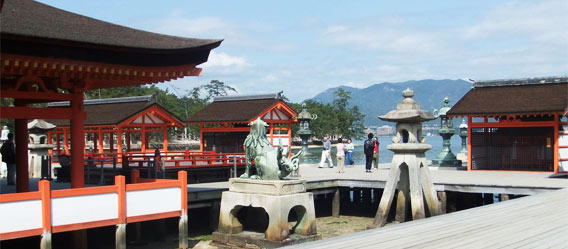
Shintoism, or Shinto, can be translated into “way of the gods”, and is the indigenous spiritual practice of the people of Japan. Although most people in Japan today see themselves as non-religious, many of them continue to observe many Shinto and Buddhist practices as part of their cultural identity.
Shintoism is recorded in Japan as early as the 5th century B.C. Originating from oral traditions, Shintoism has its own creational myth, and establishes the Japanese imperial family as the offspring of deities and the foundation of Japanese culture. The word “Shinto” is made up of the word “Shin” or Kami, which refers to spirits and gods, and “To” which comes from the Chinese word “Dao” which refers to the path or the way.
Shintoism is believed to be the indigenous belief system of the people of Japan. And although Shinto beliefs today have become integrated and influenced by foreign religious thoughts that were imported into Japan such as: Buddhism, Christianity, and Confucianism, Shintoism is still recognized as native to the people and island of Japan.
Shinto Beliefs
Kami
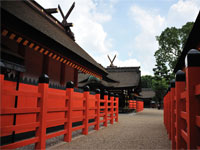 Shintoism is based on a belief in “Kami”. In Shinto beliefs, kami is the main object of worship. Although “Kami” is commonly translated into god or spirits in English, the concept of “Kami” is actually more complicated than the common understanding of god and spirit in the Western culture. Shintoism is based on a belief in “Kami”. In Shinto beliefs, kami is the main object of worship. Although “Kami” is commonly translated into god or spirits in English, the concept of “Kami” is actually more complicated than the common understanding of god and spirit in the Western culture.
In Shintoism, the word “Kami” can carry the meaning of a being or the essence of existence. The word is sometimes used to define the essence of existence that is found in all things. The word, “Kami” itself means “that which is hidden”, and the property of this concept refers to that which is sacred. However, even though all things contain kami, only those that reveal their kami nature can be referred to as kami.
Unlike gods and spirits in the Western culture, kami are not omnipotent. They are not all knowing and can sometimes make mistakes. They also do not exist in a separate supernatural realm, but inhabit the same world as humans do and in the world of nature.
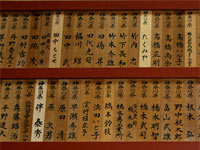 Kami are not intrinsically and essentially different from human beings, but are a higher manifestation of the same life energy. In Shinto belief, kami can refer to any of the following: Gods that created the universe, the spirit inhabiting living beings, guardian spirits of land and occupations, elements of nature such as rivers or mountains, or powerful forces of nature such as earthquakes or volcanic eruptions, and human beings who become kami after death. Kami are not intrinsically and essentially different from human beings, but are a higher manifestation of the same life energy. In Shinto belief, kami can refer to any of the following: Gods that created the universe, the spirit inhabiting living beings, guardian spirits of land and occupations, elements of nature such as rivers or mountains, or powerful forces of nature such as earthquakes or volcanic eruptions, and human beings who become kami after death.
Purity
In Shinto belief, the concept of purity is of importance. It is believed that everyone is born pure and good, and that sins and impurity occurs later in life. Impurity comes about because of moral, physical, and spiritual pollution. Known as “tsumi”, this form of pollution is similar in concept to the concept of sin, with the difference being that tsumi may sometimes occur outside of one’s control. Tsumi can sometimes include diseases disasters, and errors. Things relating to death and the dead are considered highly impure. Ritual cleansing is required to purify one’s moral, physical and spiritual state of being.
Shrines
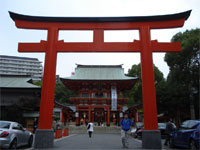 The worship of kami and purification rituals are done at shrines. Shinto shrines in Japan are recognizable by their unique gates known as “torii” made up of two tall vertical beams and two cross bar beams on the top that demarcates the scared space of the shrine from common space. Sometimes that are more than one entrance into shrine grounds, but all entrances will be marked by a torii. The worship of kami and purification rituals are done at shrines. Shinto shrines in Japan are recognizable by their unique gates known as “torii” made up of two tall vertical beams and two cross bar beams on the top that demarcates the scared space of the shrine from common space. Sometimes that are more than one entrance into shrine grounds, but all entrances will be marked by a torii.
Beyond the torii, other symbolic barriers also demarcate sacred spaces. These include statues of protection, fences, ropes and other forms of sacred markers.
Shines are open to the public. And anyone can visit a shrine. Visitation of a shrine is known as “omairi”. As shrines are sacred spaces, visitors are expected to behave respectfully. Typically there are several basic steps for a visitor during omairi:
Bow respectfully at the entrance gate. Often large washing basins, often made of stone or wood, are available for shrine visitors. These wash basins are for visitors to perform temizu.
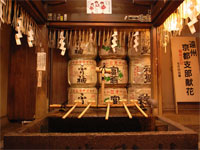 Temizu is the purification process for all visitors. First, pick up the long handled wooden scooper with one’s right hand. Fill it up with water and pour some of the water over one’s left hand for cleansing. Next switch the scooper to one’s left hand and pour some of the water over one’s right hand for cleansing. Transfer the scooper back to one’s right hand, and cup one’s left hand and pour some of the remaining water into the cupped left hand. With one’s cupped hand, bring the water to one’s mouth, take water into one’s mouth and swish the water inside one’s mouth without drinking. Spit the water out gentle back into one’s cupped hand. Never pour dirty water back into the wash basin. Now, hold scoop vertically so that remaining water will wash off the handle. Replace scooper, and proceed to enter shrine. Temizu is the purification process for all visitors. First, pick up the long handled wooden scooper with one’s right hand. Fill it up with water and pour some of the water over one’s left hand for cleansing. Next switch the scooper to one’s left hand and pour some of the water over one’s right hand for cleansing. Transfer the scooper back to one’s right hand, and cup one’s left hand and pour some of the remaining water into the cupped left hand. With one’s cupped hand, bring the water to one’s mouth, take water into one’s mouth and swish the water inside one’s mouth without drinking. Spit the water out gentle back into one’s cupped hand. Never pour dirty water back into the wash basin. Now, hold scoop vertically so that remaining water will wash off the handle. Replace scooper, and proceed to enter shrine.
Because temizu is meant to be a cleansing rite prior to entering the shrine, actions that contaminate the wash basin and scoopers are a taboo. Never pour dirtied water back into the wash basin and never place lips directly on the scooper as that is seen as contamination.
Rites and Rituals
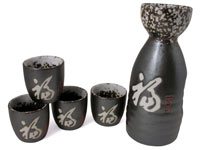 Rites of purification are known as “harae” and are done daily in Shinto shrines. Harae involve prayers and offerings of specific food and fruit items. Typical offerings include: fruits, vegetables, fish, salt, rice, mochi, sake and sakaki tree branches. Rites of purification are known as “harae” and are done daily in Shinto shrines. Harae involve prayers and offerings of specific food and fruit items. Typical offerings include: fruits, vegetables, fish, salt, rice, mochi, sake and sakaki tree branches.
Other than prayers and food offerings, water purification rituals are also conducted in shrines. Water purification includes the temizu done at the entrance of the shrine, where believers wash their hands and mouths. Sometimes, believers also conduct purifications under a waterfall or in a river.
In Shinto shrines, believers may also obtain a variety of protection amulets and protective charms. Believers can inscribe wishes that they wish fulfilled on “ema”, a small wooden plaque where wishes can be written on and placed within shrine grounds. “Ofuda” paper or metal or wood talismans are also obtainable in shrines. These ofuda are usually inscribed with names of kamis and are typically placed in homes at altars for protection. Personal amulets known as “omamori” are also available to ward off bad luck, gain better health, improve work or school performance, or to ensure safe driving and good business.
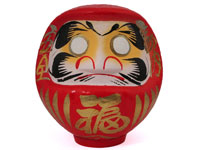 Other lucky items that are available in shrines include “daruma” a round paper doll based on the monk “Bodhidharma” with unpainted eyes. Believers paint in one eye when setting a goal or declaring a wish, and paint in the other eye when their goal is accomplished. Earthen ware bells known as “dorei” are also available in shrines. The bells are typically shaped in forms of zodiac animals and are used to usher in good fortune. Other lucky items that are available in shrines include “daruma” a round paper doll based on the monk “Bodhidharma” with unpainted eyes. Believers paint in one eye when setting a goal or declaring a wish, and paint in the other eye when their goal is accomplished. Earthen ware bells known as “dorei” are also available in shrines. The bells are typically shaped in forms of zodiac animals and are used to usher in good fortune.
Beyond the obtaining of protective amulets and purification rituals mentioned above, an ancient Shinto ritualistic dance known as “kagura” is also performed in shrines. The song and dance in kagura are meant to summon gods and blessings. The music arrangement and incantations of the kagura are meant to invite kamis to join in the dance. |
|
 |
OUR 2013 NEWSLETTERS
Way of the Gods: Shintoism in Japan
The Chinese concept of Yin and Yang
Onsen: Japanese Hot springs—Enjoyment and Etiquette
Lunar New Year 2013: The Year of the Snake
Nabemono - Japanese Hot Pots
NEWSLETTER ARCHIVES
2013
2012
2011
2010
2009
2008
2007
2006
2005
2004
2003
2002
2001
|